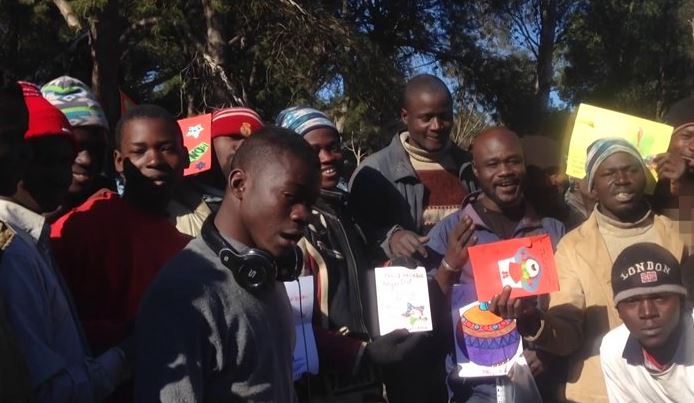Moroccan authorities thought they finally had a success story to showcase for their new immigration policy. Then everything fell apart.
Earlier this month, Morocco announced that it had successfully implemented a special program to regularize migrants. The authorities announced that 27,000 requests for regularization were being processed and that 60 percent of the cases had been approved.
Every year, hundreds of African immigrants make their way to areas near Melilla, one of two Spanish enclaves in the north of Morocco, in the hope of jumping the border fence to make their way to Europe.
On February 10, Morocco started to dismantle migrant camps near Melilla at the Spanish border in order to expel migrants out of the country. In the process, Human Rights groups report that local forces were using violence to round up migrants who were trying to migrate to Spain.
To migrant rights activists in Morocco, the story sounded familiar. In a report last year Human Rights Watch noted:
The practice of summarily expelling migrants at the border with Algeria appears to have stopped. However, research in late January and early February 2014 in Oujda, Nador, and Rabat indicates that Moroccan security forces are still using violence against migrants expelled from Melilla.
The following video upload on to Vimeo a month ago by the Human Rights Association Pro.De.In. Melilla shows the remains of the camps after they were dismantled:
The association also reports that hundreds of migrants were bused to an unknown destination. Hicham Rachidi, General Secretary of a Moroccan Defense of the Migrant Association (GADEM) writes in a blog post that he does not understand why there was a sudden rush to dismantle the camps when progress was being made:
Au moment même où l'on présentait a la presse nationale et internationale, les images du “traitement humains et compatissant” que réservaient les forces de l'ordre aux migrants sauvés de la noyade et reconduits a chaud par l'Espagne, au moment même où l'on annonçait les chiffres “glorieux” de la régularisation exceptionnelle, des opérations de ratissage ont été déclenchés contre les tranquillos qui abritaient du froid les centaines de migrants de Gourougou. Les procédures spoliées, la justice dénigrée, la loi et la dignité d'enfants, femmes et hommes bafouée.
Just when we showed the national and international press that our police forces provided “humane and compassionate treatment” to migrants who were rescued from drowning and rejected by Spain and that at the same time, just when we announced the “glorious” numbers of the regularization program, several cleaning operations were launched against the tranquillos (camps) that housed hundreds of migrants in Gourougou. The standard procedures were abused, justice was denigrated, the law and the dignity of children, women and men were scorned.
The Terre d'Asile (Land of Haven) organization collected a few testimonies from migrants. Sylvain, a migrant from Côte d'Ivoire recalls what happened in Melilla on that day:
Dès notre arrestation, nous avons été encerclés par des militaires. Il y avait six bus qui nous attendaient, on nous a ordonné d’y monter. Puis nous avons roulé pendant plusieurs heures jusque dans le désert. On n’avait aucune indication d’où on allait. On nous a conduits dans une sorte de maison avec sept pièces. Ça ne ressemble pas à une prison, plus à un camp de détention improvisé. Puis, on nous a séparés. Dans ma cellule, nous sommes douze Ivoiriens, dans une pièce d’environ 15 mètres carrés.
Upon our arrest, we were surrounded by soldiers. There were six buses waiting for us, we were ordered to climb up in the buses. Then we drove for several hours into the desert. We had no indication of where we were going. We were ushered into a sort of house with seven rooms. It did not look like a prison, more like a detention camp. Then we were separated. In my cell, we are twelve Ivorians in a room of about 15 square meters.
No Borders Morocco adds more details on the whereabouts of the migrants after the camps were sacked:
In the course of the day, between 20 and 30 buses left for Southern Morocco and distributed the Gurugu detainees around a dozen different cities: Errachidia, Goulmina, El Jadida, Safi, Kelaat, Sraghna, Chichaoua, Tiznit, Essaouira, Youssoufia, Agadir. Up until now, most people remained imprisoned in different houses, they are given food and clothing. Although they are being told that they will be freed soon, and that the Moroccan state is only taking their ID in order to regularize them, it seems more like the Gurugu inhabitants will be deported [..] In this operation, Morocco has violated many of its own laws, including the arrest of minors, the absence of individual case-by-case evaluation, or the detention of people over more than 24h without giving any reason.
The European Commission has raised concerns about how Morocco is handling the migrants’ health and well-being.
The immigration crisis is unfortunately old news at the Morocco-Spain borders. In October 2014, a photo of Migrants trying to climb a fence while golfers played a game just meters away epitomized the inequality gap that has fueled the crisis. A video later showed a Cameroonian migrant being beat unconscious by Spanish police.









1 comment